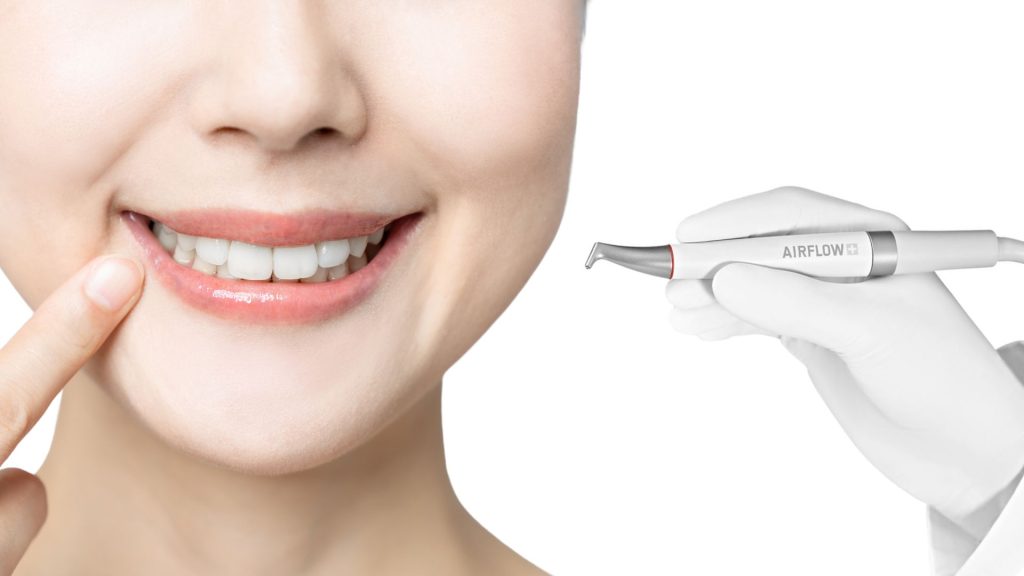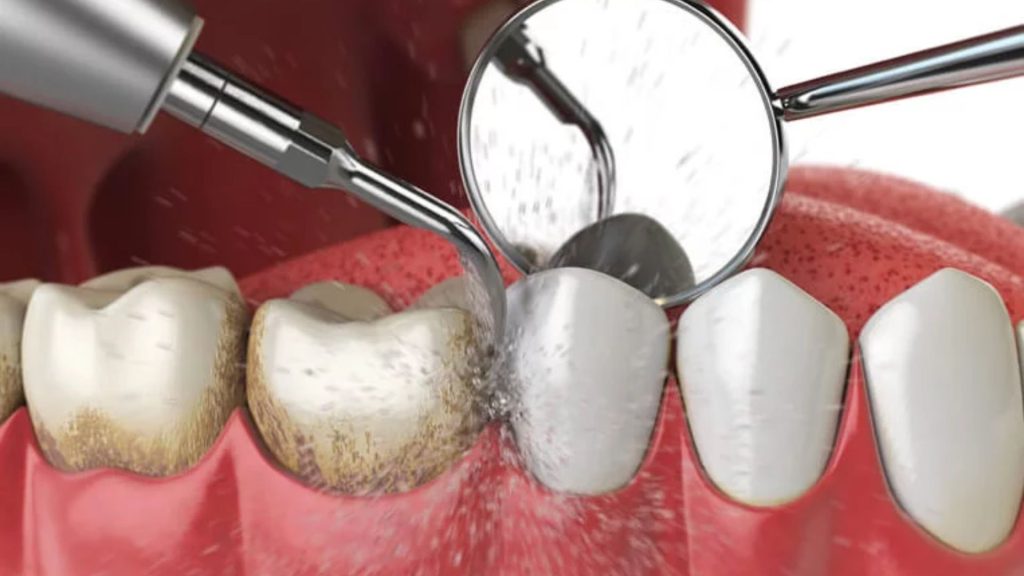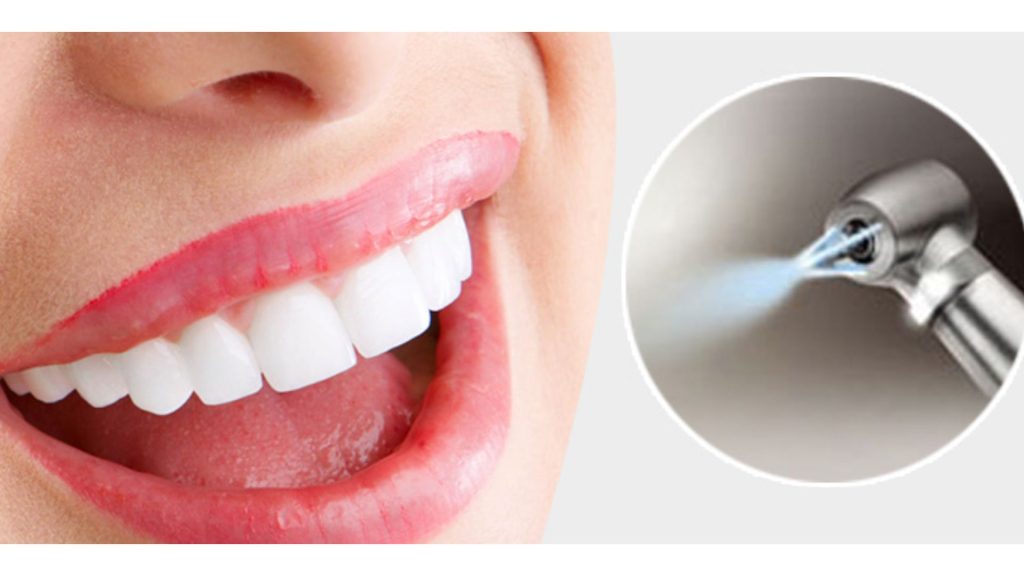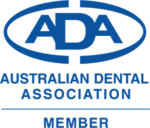Airflow dental cleaning is a contemporary and successful treatment utilized by dentists worldwide. Many patients prefer airflow dental cleaning because it’s quick, painless, and effective. However, before opting for this method, it is important to learn about the technology and process of cleaning teeth with airflow. In the post below, we’ll discuss airflow dental cleaning and its benefits:
Airflow Dental Cleaning – What Is It?

Airflow dental cleaning, commonly known as “air polishing,” employs sodium bicarbonate powder, water, and compressed air to clean teeth. Patients who have trouble brushing their teeth prefer airflow dental cleaning because it’s safe and painless. Also, it brightens teeth by eliminating stains from smoking, coffee, tea, and red wine. Airflow cleaning uses a tiny spray of sodium bicarbonate powder, water, and air to gently and efficiently remove surface stains and residues. This method is mild, fast, and effective.
Why Is Airflow Dental Cleaning Effective?
Many benefits over time-honored techniques have led to the widespread acceptance of airflow dental cleaning as an efficient alternative. Here are the benefits of airflow dental cleaning:
- Effective residue removal: It eliminates plaque, stains, and deposits better than sodium bicarbonate powder, water, and compressed air.
- No pain: Like ultrasound and brushing, airflow dental cleaning is painless. Since compressed air and water don’t harm teeth and gums, patients feel more comfortable during teeth cleaning.
- Deeper cleaning: It helps dentists clean hard-to-reach teeth, lowering the risk of tooth decay, periodontal disease, and tooth decay.
- Minimizing bleeding gums: It reduces bleeding gums following teeth cleaning, reducing patient pain and suffering.
In sum, airflow dental cleaning is a safe and effective way to clean teeth and gums.
Who Should And Shouldn’t Do This Therapy?
Teeth cleaning is essential to dental health, and various ways may work for different individuals. Many people trust and use airflow dental cleaning. Yet, can everyone benefit from this approach? Find out who can and cannot do airflow dental cleaning in the following section:
Who’s Suitable For It?
White teeth boost confidence and dental health. However, for various reasons, maintaining and caring for our teeth is often not enough. That’s why new teeth cleaning treatments like airflow dental cleaning are becoming more popular. Are you suited to this method? See below for airflow dental cleaning objects:
- Smokers, tea, coffee, and alcoholic beverage drinkers with tooth plaque and stains.
- People with sensitive teeth, gingivitis, or caries who don’t want painful tooth cleaning.
- Machine, computer, phone, and stationery users who don’t brush their teeth.
- Those who desire clean, white teeth, a more confident grin, and fewer dental visits.
However, you should consult your dentist to determine whether
Who Can’t Do It?
Although there are many positive outcomes for oral health when using airflow dental cleaning, the procedure is not appropriate for everyone. These items should not be cleaned with airflow dental cleaning:
- People experiencing gum issues, such as gingivitis or bleeding gums.
- People with sensitive teeth, cavities, or enamel loss.
- Heart failure, diabetes, excessive blood pressure, and blood clot sufferers.
- Those sensitive to dust, chemicals, or cleaning products.
- People having dental or surgical issues.
- Children under 14.
Thus, if you fall into one of the above categories, consult your dentist about the best teeth-cleaning method for your oral health.
Scale And Clean vs Airflow Dental Cleaning

Oral hygiene requires teeth cleaning. However, the right teeth cleaning method for each person’s needs and the oral condition is crucial. Today, airflow dental cleaning and scale and clean are popular. Next, we’ll compare these two ways:
| Criteria | Clean Scales | Dental Airflow |
| Cleaning method | Use hard tools to remove plaque and scrub teeth. | To eliminate plaque and grime, use foam cleaner to generate suction and depress pressure. |
| Effectively remove plaque | Removes plaque but hard to remove deep and tight plaque. | Effectively removes plaque deep in the oral cavity and between teeth. |
| Safety for teeth | May cause damage to tooth enamel and gums if not performed properly. | Safe, does not cause damage to tooth enamel and gums. |
| Pain and discomfort | May cause pain or discomfort during cleaning. | No pain, no irritation or discomfort. |
| Cleaning time | More time-consuming due to having to do every detail. | Fast, only takes about 30 minutes to clean the entire oral cavity. |
In conclusion, airflow dental cleaning is more effective and safer than scale and cleaning. Scale and cleaning can only remove surface plaque, but airflow may remove deep plaque. Furthermore, Airflow causes no pain or discomfort to the patient and takes less time to perform.
Cleaning Teeth Using Airflow Dental In Bassendean

Airflow dental cleaning is a new teeth cleaning treatment utilized worldwide. This procedure uses high-pressure compressed air, water, and soda to clean teeth rapidly and painlessly. Cleaning your teeth is one of the most critical tasks in dental hygiene and general wellness. However, many people are afraid of the dentist. People often worry that using a dental cleaning machine will hurt or be uncomfortable. However, airflow cleaning eliminates these concerns. So, how exactly will airflow be used to clean teeth? Discover the details below:
Step 1: Oral health check
To check the patient’s teeth, gums, lips, and jaw, the dentist will undertake an oral exam before cleaning.
Step 2: Manual tooth cleaning
Then, Bassendean dentists use tooth saws, toothpicks, and brushes to remove plaque and stains from your teeth, especially in hard-to-reach areas.
Step 3: Spray water and antibiotics
Next, Dr. Bassendean will spray purified water into the patient’s mouth during airflow cleansing. Also, they can utilize antibiotics to kill pathogens.
Step 4: Using the airflow system
After physically cleaning the teeth, the dentist will utilize the airflow technology to clean deeper. Using a forming element, the air stream cleans well.
Step 5: Interdental cleaning
Next, the dentist will clean the teeth with a special thread.
Step 6: Polishing
After the cleaning process is complete, your teeth will be polished using a special tool to leave them looking smooth and shiny.
Step 7: Oral care consultation
Finally, the dentist will instruct the patient on proper brushing, flossing, mouthwash use, and dental exams.
In conclusion, competent dentists execute airflow cleaning at Bassendean’s dental clinic, assuring patient comfort and safety. Cleaning teeth with airflow at Bassendean removes plaque and sebum and improves tooth decay, gingivitis, and tooth discoloration.
Patient Experience With This Method
Many patients have found that the method of cleaning their teeth using airflow has been the most effective. After this procedure, these patients’ experiences.
- Tam, 28 years old, said she was always anxious about going to the dentist. After the dentist introduced her to airflow cleaning, she tried it and was surprised by how fast and pleasant it was. She has never felt such relaxation and cleanliness in her mouth after airflow cleaning.
- Hai, a 35-year-old patient, has a difficult time getting regular dental treatment and thus has many cavities. He had better breath and cleaner teeth after airflow tooth cleaning. Also, he added that brushing his teeth is painless and he no longer worries about dental deterioration.
- Mai’s 42-year-old teeth are yellow because she smokes and consumes coffee. She was pleased with her brighter teeth after airflow cleaning. She claimed the treatment is less unpleasant and uncomfortable than the usual approach, and she would keep using it to preserve dental health.
Conclusion
Can Pregnant Ladies Use Airflow Dentistry?
Most pregnant women and fetuses are unaffected by airflow dental cleaning. However, airflow dental cleaning can be dangerous for pregnant women with gingivitis, bleeding gums, or other dental issues. mother-child health. Therefore, pregnant women should inform their dentist about their pregnancy and dental health issues before airflow dental cleaning. The dentist will test the pregnant woman’s health before cleaning her teeth. Furthermore, pregnant women should keep up a healthy diet and practice good dental hygiene to lessen the likelihood of dental issues. Also, pregnant women should have dental examinations and cleanings.
Can You Clean Your Teeth At Home Using Airflow?
No, you can’t. Dental experts clean teeth using airflow. Airflow dental cleaning shouldn’t be performed at home to get the best results and prevent tooth health issues. To maintain your teeth clean and healthy, see a dentist periodically for inspection and treatment.
Does Airflow Dental Cleaning Cause Problems?
Like all oral care methods, airflow dental cleaning can cause certain complications, but these cases are quite rare and usually not serious. Some complications may include:
- Tooth sensitivity: Airflow dental cleaning may leave your teeth sensitive. The good news is that after a few days, this often goes away.
- Water or dust in dental mucous membranes: Dust and water may induce gingivitis or tooth mucous membrane damage in the subgingival region. However, this is extremely rare.
- Causes infection: Without proper teeth cleaning, bacteria can enter the bloodstream and cause many health problems. However, these cases are also very rare.
Therefore, to reduce risk, airflow dental cleaning should be done at professional, hygienic dental clinics. Taking care of one’s teeth and gums on a consistent basis is another way to lessen the likelihood of issues.





